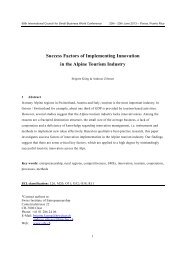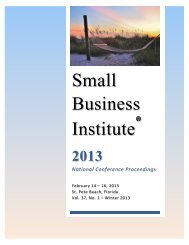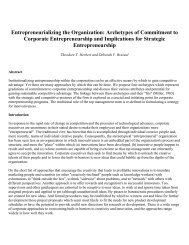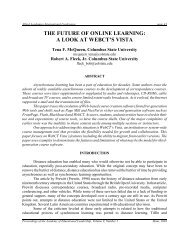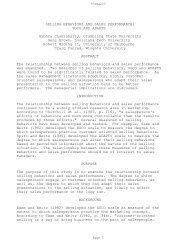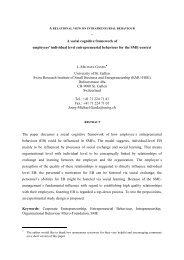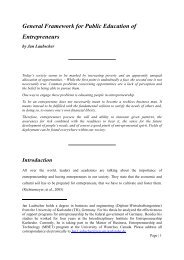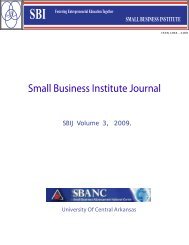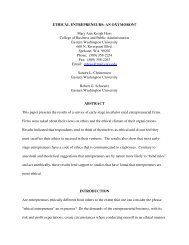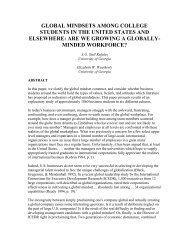related diversification in a franchised service business
related diversification in a franchised service business
related diversification in a franchised service business
You also want an ePaper? Increase the reach of your titles
YUMPU automatically turns print PDFs into web optimized ePapers that Google loves.
USASBE_2012_Proceed<strong>in</strong>gs-Page0195<br />
Scudamore when he was 18 years old. By 2009 it had more than 250 franchisees <strong>in</strong> Canada, the<br />
US, and Australia. Nick Friedman estimated that 1-800-GOT-JUNK earned annual revenue of<br />
around $80 million. The bus<strong>in</strong>ess models of the two companies were similar. Both were<br />
bus<strong>in</strong>ess format franchises that operate a centralized call center, national and regional<br />
advertis<strong>in</strong>g, unified brand<strong>in</strong>g and public relations, tra<strong>in</strong><strong>in</strong>g for franchisees, and similar capital<br />
requirements. Accord<strong>in</strong>g to its website, 1-800-GOT-JUNK required prospective franchisees to<br />
have about $95,000 <strong>in</strong> liquid capital to start a franchise. The franchise fee was $18,000 per<br />
region with additional regions cost<strong>in</strong>g $9,000 each. In many US markets, College Hunks<br />
Haul<strong>in</strong>g Junk and 1-800-GOT-JUNK were compet<strong>in</strong>g head-to-head.<br />
While 1-800-GOT-JUNK is the most visible competitor <strong>in</strong> the <strong>in</strong>dustry, CHHJ also faced<br />
competition from legions of regional and local companies. In every city, there were local junk<br />
haul<strong>in</strong>g <strong>service</strong>s that could be found by search<strong>in</strong>g the Yellow Pages, Yahoo Local, or Google.<br />
These competitors had a lower cost structure and could usually offer prices that undercut CHHJ.<br />
For example, the CHHJ franchisee <strong>in</strong> Orlando, FL faced competition from Orlando Lawn Patrol,<br />
LLC and Haul Away Harry’s. These companies appeared to have some market<strong>in</strong>g budget and<br />
some presence on the <strong>in</strong>ternet. Another tier of competitors existed at even a lower cost position.<br />
These were the casual or part-time <strong>service</strong> providers that might work only <strong>in</strong> their own<br />
neighborhoods. They were referred to as “a teenager with a pick-up truck” and typically had no<br />
<strong>in</strong>surance, no website, and no market<strong>in</strong>g efforts besides post<strong>in</strong>g signs on telephone poles. Entry<br />
barriers for these companies could hardly have been any lower, and they did provide a <strong>service</strong><br />
that was valuable to some customers. CHHJ was certa<strong>in</strong>ly aware of these providers and had<br />
<strong>in</strong>tentionally refused to cut prices to match them.<br />
STRATEGIC ISSUE<br />
When they moved their company to Tampa <strong>in</strong> 2008 Friedman and Soliman saw their roles as<br />
build<strong>in</strong>g an effective system so that their franchisees could become successful. The Tampa and<br />
Wash<strong>in</strong>gton locations were company-owned (<strong>in</strong>stead of franchises) but Friedman and Soliman<br />
removed themselves from runn<strong>in</strong>g the local bus<strong>in</strong>esses and hired managers <strong>in</strong>stead. The ma<strong>in</strong><br />
issue confront<strong>in</strong>g franchisees was f<strong>in</strong>d<strong>in</strong>g the optimal balance between pursu<strong>in</strong>g customer<br />
retention and customer acquisition (Peifer, 2005). Customer retention <strong>in</strong>volved build<strong>in</strong>g<br />
relationships with exist<strong>in</strong>g customers so that they ma<strong>in</strong>ta<strong>in</strong>ed loyalty, became repeat buyers, and<br />
spread positive word-of-mouth advertis<strong>in</strong>g about the company. Customer acquisition <strong>in</strong>cluded<br />
all the activities to encourage non-customers to abandon compet<strong>in</strong>g brands, or to enter the<br />
market for the first time.<br />
In the junk removal bus<strong>in</strong>ess, most customers were <strong>in</strong>frequent buyers. They might require junk<br />
removal <strong>service</strong>s once or twice per year, or maybe even less. Infrequent purchase was not<br />
usually due to poor <strong>service</strong> from CHHJ. Instead, people usually accumulate junk slowly and do<br />
not regularly need to pay for it to be removed. Consequently, CHHJ franchisees spent almost all<br />
their market<strong>in</strong>g resources on customer acquisition <strong>in</strong>stead of retention.



